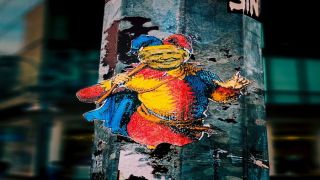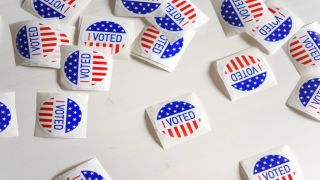The Shaft Frankenholz Featured
- Written by
- font size decrease font size increase font size
 Compressor hall, Shaft Frankenholz Saar, kasaan media, 2020
Compressor hall, Shaft Frankenholz Saar, kasaan media, 2020
Bringing life into the past
Admittedly, Frankenholz is not the navel of the world. Bexbach certainly isn't either. Very few people know these places.
But in mining, the two places were once world leaders. That was a long time ago.
What remained are the ruins of the compressor house, the skeleton of a company-owned filling station, supply lines and parts of former shaft superstructures and much other debris. These onces served many masters who, in the course of history, went through the ages to extract the "Saar-Gold" from the depths and are now left to decay. The villas of the then administrators are now already sought-after residential buildings.
But now Andreas Kroth is planning in cooperation with the Frankenholz-Gewerbecenter (Frankenholz commercial centre), to rebuild the compressor hall of the former Frankenholz mine, around which a road is to be laid. This stake is where the new Frankenholz centre is to be built. Not only for culture but also to stimulate social interaction.
Along this access road, numerous single-family houses are to be built on the current wasteland. Full of enthusiasm, the civil engineer Andreas Kroth describes his many ideas in the understanding of history and the cultural context. What matters is the integration of the remaining buildings into a new settlement. No efforts are spared to implement the idea. A survey was launched via Facebook to find out what the citizens of Bexbach would like to see. This questioning resulted in numerous suggestions, which Kroth now describes as his plan.
A further waiting would give the ruins, which have been exposed to the weather and decay for years, "the rest", only to be unable even to preserve the gutted façade. The walls show signs of decay and weather-related mould growth.
Hence, the sensible considerations come at the right time. Urban development plans that combine environmental protection and design and create jobs that are urgently needed in this area of the Saarland. Of course, the planner is aware that it is an investment of millions that has to be made. But it is worth it.
An extraordinary mirror of Saar history
The compressor house, which was once used to supply oxygen underground, still has its unusual and light-flooded roof construction, which extends almost over its entire length. The walls show much of their former splendour, which has been lying fallow since 1959. With the handover of the Saar by the civil administration of the French occupying power, the operation of the Frankenholz/Saar shafts was finally stopped.
An eventful history accompanied the area around the former Frankenholz mine. Frankenholz was a mirror of Saar's history, and it has always been one of the most important.
Since 1729 the industrial extraction of coal in the Frankenholz pit was attempted. At the beginning of the century, the density of methane gas underground led to the use of an underground gas storage facility to use the gas to heat the mine's boiler plant. It was unique.
In 1919, following the unification of the Treaty of Versailles, the Republic of France became the owner of all mines in Saar. In 1923, a 100-day strike broke out at the mine, but it affected the entire Saar region. This strike was not only due to the partly inhuman working conditions but also to the political situation. At that time, more than 2800 people were working in the mine. In 1930, the highest output was reached, with over 480,000 tonnes of coal extracted. Thus, the mine became one of the most historically significant industrial sites in the Saarland.

Frankenholz Mine, 1931, from the "Saarbruecken Miners' Calendar
On January 2, 1941, there was a firedamp explosion in which 41 miners lost their lives. It was a black day for the coal in Saar. On January 1 there was heavy fire at level 10 of the colliery. As a consequence of the war, there was a disturbance in the Homburg power plant, and the remedial measures had to be omitted on this day. However, as the coal had to be extracted, a devastating firedamp explosion occurred shortly before midnight on January 2, 1941. After the accident, work in the mine was stopped entirely. Jules Baumann, a charismatic administrator, took over the shaft after the war and for a while coal could be extracted again. At that time, horses were still used to pull the lorry's underground. This practice came to an end in 1960, at a time when the Saarland was undergoing the most significant upheaval in its history.
It would be an unspeakable loss to let the industrial culture, which was once the hard-earned income for many Saarland families, fall into disrepair. But there is still the civil engineer Kroth, who moved here from the Ruhr area and who has dedicated himself with skin and hair to the extensive redevelopment of the former territory of the Frankenholz mine. These are more than dreams that Kroth conveys; they are plans that only need to be implemented.
The planner and all his comrades-in-arms would welcome it if the state government in Saarbrücken would support the efforts to restore this property. Europe, the EU, too, will undoubtedly be interested in the eventful history of this building, because it was and is a piece of German-French history.
Construction engineer Kroth has precise ideas and knows how to realize them. No one has any doubt about that,- he cultivates what has been forgotten since 1959.

Kroth is someone who tackles things, who wants to preserve what has remained of the pride of the Saarland mines and transfer it to modern times.
What is the outlook? How should the project be implemented?
Many concepts are conceivable; Bexbach has a mining museum. For example, the historically valuable compressor hall could be turned into a meeting place that also represents the concerns of the former occupying forces and the long-standing friendship between Germans and French. But Kroth has many other ideas that he would like to present. The building has two basements, which in its actual use had the advantage that supply shafts and pipes could be led under the surface. Now it could become a discotheque or a bowling alley. There has been a long tradition of bowling in Bexbach, which can look back on history in the so-called Bundesliga.
A flexible event hall, which could also be used as an exhibition space, is one of the ideas that electrifies Kroth. Children can be left virtually downstairs, while the adults pursue their interests, the youngsters are looked after downstairs. An excellent concept that could be viable during this time. Regional gastronomy is also being considered. There is still a little time left before the starting signal is given.
As Andreas Kroth emphasized in the interview, the intention is to create a homepage soon on which the concerns and ideas of the citizens are received. The website is to accompany the development of the entire area. If you don't want to wait for the homepage, you are welcome to write to us; we will forward the mails: This email address is being protected from spambots. You need JavaScript enabled to view it. or This email address is being protected from spambots. You need JavaScript enabled to view it.
Latest from
- Deserted Russian pilot Kuzminov found dead in Spain
- What has Wikileaks to do with the French Revolution?
- Mutilated bodies found in Antalya
- A shame for Germany - meeting of the Neo Nazi movement on the Lehnitzsee
- Resistance against him is mandatory - Björn Höcke and the National Socialist dictatorship














